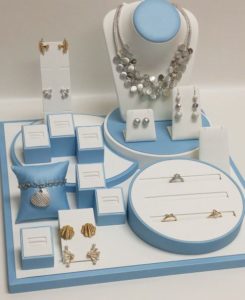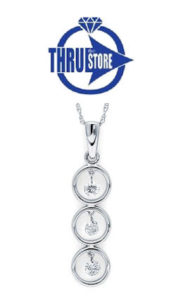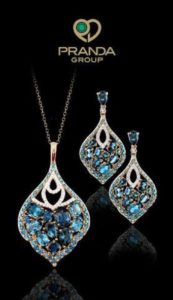Stay on Message
Every company has a brand, whether it makes it a priority or not. Simply put, a brand is what people think about you—the impressions they have when hearing or seeing your name. Initially, your brand is reflected in your logo/hallmark then supported by your messaging. These experiences influence attitudes and opinions about your company.
 Building a brand is a long-term investment and consistency is critical in all messaging from displays and how you merchandise to packaging and how you market, tells Christopher Stock, design director for Rocket Redbox at its San Clemente, California location. “Cohesiveness and value branding go far to help jewelers have their own identity to help maintain and attract customers.”
Building a brand is a long-term investment and consistency is critical in all messaging from displays and how you merchandise to packaging and how you market, tells Christopher Stock, design director for Rocket Redbox at its San Clemente, California location. “Cohesiveness and value branding go far to help jewelers have their own identity to help maintain and attract customers.”
Build equity in your brand by being consistent. Cites Rob McDorman for North Star Marketing in Burlington, North Carolina: Consistency manages perceptions; connotes professionalism, purpose and stability; conveys outlook and attitude; builds on previous successes; and instills confidence and eliminates brand confusion. Consistency protects your investment!
“All the elements must look the same and support one another,” emphasizes Rebecca Foerster, Leo Schachter Diamonds in New York City. “When you see an element of that brand it should trigger what it represents (think Tiffany and its blue box). The logo must be consistent. The color palette must always be used. All of this creates an aesthetic and consumer perception of your brand—approachable, fun, trendy, elegant, classic…”
Spotlight Special
Foerster reminds jewelers that no brand can be all things to all people, so pick your target based on your merchandise and market, then build your brand elements that appeal to that group. Jewelers must determine who they are, who their customers are, and how they can deliver the best retail experience for them, concurs Mike Kaplan for Rocket Redbox.
 Your brand is intended to be effective with a specific market segment. “These are the people who value what your organization does, makes, and delivers,” explains McDorman. “They care about the promises your brand makes to them. They make buying decisions based on their perceptions of brand quality.”
Your brand is intended to be effective with a specific market segment. “These are the people who value what your organization does, makes, and delivers,” explains McDorman. “They care about the promises your brand makes to them. They make buying decisions based on their perceptions of brand quality.”
Pam Danziger, president of Unity Marketing, Stevens, Pennsylvania and author of “Shops That Pop, advises jewelers to focus on what makes their stores special, different, and distinctive. “Lead with your specialness, which becomes your brand.” She cites Doyle & Doyle, a jeweler in New York City’s meat packing district, as an example of a shop whose atmosphere, store design and merchandise create a single experience: “an art-gallery setting selling great grandmother’s jewelry in ultramodern style.”
Brand Partnerships
To create an extraordinary shopping experience for customers, jewelers must offer a unique vision with carefully curated products and services delivered in a personal and personalized way, advocates Danziger.
 Jewelry brands that speak to the jeweler’s brand identity are an important part of the overall story. Partnering with strong quality brands is critical when building your own brand, says Maren Pfister, merchandise manager, Ostbye, Minneapolis, Minnesota. Strong brands provide support tools to help tell the story, like Ostbye’s Thru the Store™ system that offers, custom design process, online jewel box, marketing artwork, branded displays, flyer programs, co-op advertising, trade-up program, and stock balancing.
Jewelry brands that speak to the jeweler’s brand identity are an important part of the overall story. Partnering with strong quality brands is critical when building your own brand, says Maren Pfister, merchandise manager, Ostbye, Minneapolis, Minnesota. Strong brands provide support tools to help tell the story, like Ostbye’s Thru the Store™ system that offers, custom design process, online jewel box, marketing artwork, branded displays, flyer programs, co-op advertising, trade-up program, and stock balancing.
Well-constructed brands bring a unique point of view and selling proposition along with a brand promise to a jeweler’s product portfolio. “If the brand demonstrates differentiation, cohesive design, expert craftsmanship, marketing support and quality brand collateral, the competitive retailer can evolve their existing model to attract new customers and build customer loyalty with a case line placement,” explains Debra Puzio, creative director for Pranda and the Ariva brand, New York City. “A good brand has standards and upholding these standards through continuity is key. Purchased programs should include a strong collateral program that is designed to support the growth of the brand, build equity and further increase the integrity of the jewelry retailer.”
Virtual Experience
The virtual experience is as tangible as the in-store one as it keeps the conversation going. “Embrace the digital age,” urges Puzio. It is critical for a jeweler to have a good website. While e-commerce is becoming more important for jewelers to have, it is something they can evolve. A simple site that showcases the jeweler’s store footprint and company positioning is essential. She notes that Ariva features jewelers on the brand’s website with image, bio and retailer link. She cites Facebook, Pinterest and Instagram key social media channels to generate buzz and create a community environment.

Marty Hurwitz with the Los Angeles-based MVI Marketing, and its Jewelry Consumer Opinion Council, hails video content a great asset to increase user engagement, and is rapidly becoming the most versatile and effective marketing you can add to your website. MVI offers custom editions of its Jewelry Consumer News videos that explore the latest in style, trend and fashion. It just completed a JCN custom edition for SDC Designs and Jared (www.jewelryconsumernews.com/video/jcn-mothers-day-2016.php), and is developing one for Interjewel, both Plumb Club brands.
Research shows higher conversion rates and visitors spending more time on websites with videos, reports Vidyard, a software company in Kitchener, Canada that analyzes video performance. Citing that video content is search engine friendly; a rich media source that inspires viewer interest and more clicks; a cost and time-efficient way to produce compelling online content that helps with link building, page authority and bounce rate; and is more personal and persuasive.







